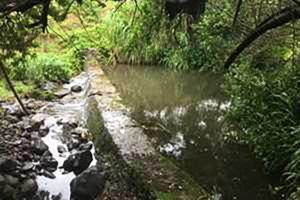 Ensuring continual mauka to makai streamflows in Lāwa‘i Stream on Kaua‘i was made possible by the establishment of an interim instream flow standard (IIFS) by the Commission on Water Resource Management on Tuesday. The IIFS permits the protection of valuable instream uses.
Ensuring continual mauka to makai streamflows in Lāwa‘i Stream on Kaua‘i was made possible by the establishment of an interim instream flow standard (IIFS) by the Commission on Water Resource Management on Tuesday. The IIFS permits the protection of valuable instream uses.
Historically, Lāwa‘i Ditch diverted streamflow by McBryde Sugar at the 580-foot elevation for sugar production in the Koloa region. Following the closure of McBryde Sugar, McBryde Resources operated the diversion and ditch to support the Lāwa‘i Agricultural Park and non-potable water needs of the Kukui‘ula development.
Lāwa‘i Stream is located on the southern coast of Kaua‘i and supports habitat for native aquatic fish, and many aesthetic, recreational, and educational uses. The stream also sustains an important estuary and nearshore environment relied upon for traditional fishing.
The IIFS of 2.41 cubic feet per second (or 1.56 million gallons per day) plus high flows completely protects the stream’s baseflow, supports increased flushing of sediments that will improve fish habitat, and ensures sufficient water remains available off-stream for reasonable and beneficial agricultural uses dependent on Lawai Ditch. This decision is the result of more than four years of work by Commission staff, including collaboration with community members, organizations, and McBryde Resources. During drought conditions, McBryde Resources will need to rely more on groundwater to support its non-potable water needs.
After unanimous approval of the Lāwa‘i IIFS by the Commission, Chair Suzanne Case said, “I really want to thank the staff, the users, and community members for all the tremendous work that went into this. It’s wonderful to have an updated and meaningful instream flow standard that is carefully tailored to address a lot of different types of concerns.”
Water Deputy Kaleo Manuel added, “It’s so important to re-establish relationships between communities and water. The interim IIFS does just that by restoring continuous streamflow and reconnecting mauka to makai resources with the communities that rely on them. “



